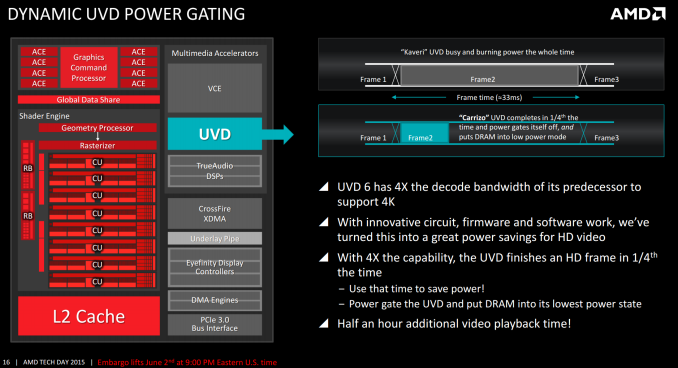AMD Launches Carrizo: The Laptop Leap of Efficiency and Architecture Updates
by Ian Cutress on June 2, 2015 9:00 PM ESTUnified Video Decoder and Playback Pathways
A typical consumer user experience revolves a lot around video, and AMD identified for Carrizo a big potential to decrease power consumption and increase performance in a couple of different ways. First up is adjusting the path by which data is moved around the system, particularly as not a lot of video matches up with the native resolution of the screen or is scaled 1:1.
When a video exhibits a form of scaling, either it is made full screen and scaled up or it is a higher resolution video that scales down, that scaling is typically performed by the GPU. The data leaves the decoder (either hardware or software), enters system memory, moves into the graphics memory, is processed by the GPU, moves back out to memory, and then is transferred to the display. This requires multiple read/write commands to memory, requires the GPU to be active but underutilized, and this happens for every frame. AMD’s solution to this is to provide some simple scaling IP in the display engine itself, allowing for scaled video to go from the decoder to the display engine, leaving the GPU in a low power state.
The video playback paths at the bottom of this side show the explanation graphically, and AMD is quoting a 4.8W down to 1.9W movement in power consumption for these tasks. Note that the 4.8W value is for Kaveri, so there are other enhancements in there is as well, but the overall picture is a positive one and AMD quotes a 500mW of APU power savings.
The Unified Video Decoder (UVD) has been built to support the above codecs, with HEVC decode on die as well as native 4K H.264 decode as well. I’ll come back to the 4K element in a second, but what is perhaps missing from this list is VP9, the codec used by Google for YouTube. YouTube is still the number one source for video content on the web, and as Google is transitioning more to VP9, as well as AMD’s competition advertising it as a perk on their latest hardware, it was perhaps confusing for AMD to miss it out. I did ask on this, and was told that they picked HEVC over VP9 as they believe it will be the more important codec going forward, particularly when you consider that the majority of the popular streaming services (NetFlix, Hulu, Amazon) will be using HEVC for their high definition titles.
Back onto the 4K equation, and this is possible because AMD has increased the decode bandwidth of the UVD from 1080p to 4K. This affords two opportunities – 4K video on the fly, or 1080p video decoded in a quarter of the time, allowing the race to sleep for both the UVD and DRAM. Despite a 75% reduction in work, as the UVD does not use that much power, it results in only 30 minutes of extra video playback time, but it is welcome and contributes to that often marketed ‘video playback’ number.













137 Comments
View All Comments
AS118 - Saturday, June 6, 2015 - link
I already signed up on the mailing list that tells you when Laptops with Carrizo come out and are ready to buy. You can do so on AMD's website if you're interested. The H.265 hardware decoding alone interests me, and all the other features like program-specific acceleration and the better GPU performance for mainstream games is nice.If you only play stuff like LoL or Counterstrike, or browser games or even older games on GoG and Steam, the A10 and up look like they'll be quite good.
ivyanev - Sunday, June 7, 2015 - link
As the performance is more than enough for everyday use, and the price is good, using it in mini PC would be great.watzupken - Thursday, June 11, 2015 - link
I was thinking the same thing. If they can produce this for use in those NUC sized PC, I will consider getting one as HTPC if the price is right.Fujikoma - Sunday, June 7, 2015 - link
AMD not including VP9 support is a mistake. They could always drop it if YouTube isn't as popular, but a lot of video in media articles tends to be linked to YouTube.It would be nice to see a die shrink with AMD adding more CPU cores to make up the difference to at least compete with Intel in number crunching.
ivyanev - Tuesday, June 9, 2015 - link
Try using h264ify plugin for chrome - it disables the vp8 and vp9 video, and youtube plays the mp4 versions - butter smooth and efficientfigus77 - Thursday, June 11, 2015 - link
I think everyone should look at APU with respect, apu is the future of pc and notebook, HBM on next AMD GPU will be a start and test for new APU with HBM on chip ram, that will be faster and faster than any ddr4 now available in market and probably any 'on motherboard' ram we will ever see, AMD could start a revolution in PC market, and other will probably copy them in short, even with faster cpu, but IF that will happens we shall be grate to AMD.And sorry for my english...
JDub8 - Tuesday, June 16, 2015 - link
Something I'm always interested in but is never addressed in these articles. The UVD playback and all its magical power savings - what codecs/players support it? If I have a CCCP installed will MPC-HC automaticall benifit? Or will that be reserved for some cyberpower payware dvd/bd player?